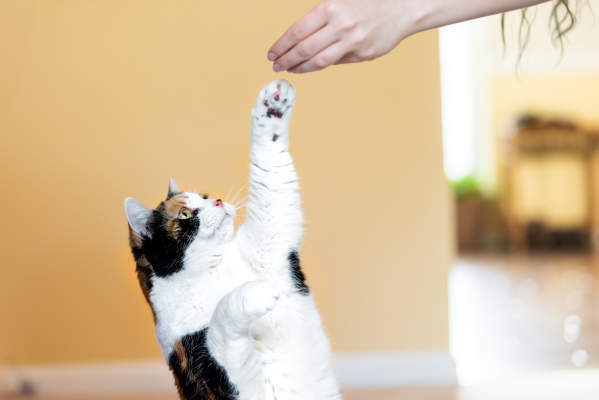As a cat parent, you already know the perks of having a feline companion — but did you know that you can also train your cat to do cool tricks? A lot of people think that cats are impossible to train, but with a little effort and patience, they can learn tricks just like dogs can.
Set Up A Reward System
First things first: It’s important to plan ways to reward your cat for their efforts. Remember that cats, unlike dogs, won’t learn from what some pet owners would consider “discipline.” The most effective way for a cat to learn is to focus on good behaviors and reward them. Furthermore, punishing your cat can make them disengage from learning altogether — and it can induce stress, which may lead to behavioral and health problems.
Wet food, canned tuna, cubed chicken, or store-bought treats are all great options for rewards. According to Lianne Virenius, DVM, veterinarian at Antioch Dog and Cat Hospital in Kansas City, "These rewards should be very small — you don't want to contribute to a weight problem when training your cat." Some cats might prefer extra attention instead of food, but if that's the reward, make sure it comes after the desired behavior so they understand why they are getting a little extra love.
Get A Clicker
Clickers are an excellent and commonly used tool for training cats. They help your cat associate the desired behavior with a treat so they understand why they are being rewarded. Typically, they will obey a command, hear a click, and then get a treat — it helps them catch on more quickly. "Clicker training is excellent for active cats who thrive on mental stimulation," says Dr. Virenius.
Tricks to Try
When you begin your training sessions, remember to keep them short so your cat stays focused. Using the clicker during the desired behavior, not after it, is the key to helping your cat associate the sound with the behavior and getting a treat. It’s also helpful to train your cat at the same time every day — before mealtime, if possible. Here are a few fun tricks to get started with.
1. Come On Command
Cats can learn to respond to your voice and run your way. The "come" command can be a useful tool to coax your cat back inside, especially if they are prone to dashing out the door. Make a distinct noise (calling their name, whistling, or clicking your tongue) before feeding your cat. They will begin to associate that noise with food and your cat will eventually head your way when they hears it. Then start to use the same noise outside of feeding times. Make the noise, click your clicker when your cat comes, then give them a treat. Repeat this up to 10 times per session to reinforce the behavior.
2. Stay

You can also try to train your cat from door dashing to begin with. Try training them to sit and stay on a stool that’s far away from the door to help prevent your cat from getting outside and hiding or putting themselves in danger. Just use treats and a clicker to reinforce their behavior every time they sit and stay on the stool.
3. Shake Hands
Cats can shake hands just like dogs. Start your training session with a treat in hand, then align yourself on the same level as your cat. Tap their paw while saying “shake,” and use the clicker when they move their paw. If your cat starts to paw at your hand, quickly pull your hand and treat away so you don’t accidentally reward the pawing behavior. Repeat this until your cat offers its paw in response to you saying “shake” without tapping on them. From there, according to the Animal Society for the Prevention of Cruelty to Animals (ASPCA), you can start to increase how far your cat has to reach until they get closer and closer to touching your hand. This trick might take a few sessions stretched out over a couple of days for your cat to master it.
4. Jump Through Hoops
All cats need exercise — even indoor cats require outlets to climb, pounce, ambush, and run, according to the ASPCA. Once your cat has learned that a clicker means a treat, place a small hula hoop between you and your cat and have a treat ready. Hold the treat and clicker directly in front of the hoop, click, and wait for your cat to walk through toward the treat. After a few rounds, your cat should walk through the hoop after just hearing the click. Once your cat gets the hang of this, you can add multiple hoops.
Take It Slow
Don’t rush into teaching your cat a bunch of new tricks all at once. Break it down into one small trick or step at a time and work your way into further tricks. Keep training sessions to only two minutes — or 10 training treats — so that your cat’s attention doesn’t wander. It might take months for your cat to get the hang of a trick—but if you’re patient, it will pay off.
